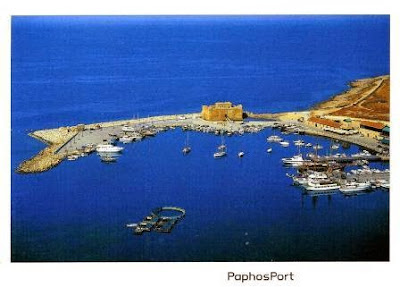A few months ago I met
Paulo and he gave me a bag full of cards. A few days ago I've got another gift from him, an envelope with 135 cards. How nice is that?? These 4 are from Cyprus.
© Omnicard Photobank
Limassol is a city on the southern coast of Cyprus and capital of the eponymous district. Limassol is the second largest urban area in Cyprus.
The Port of Limassol is one of the busiest ports in the Mediterranean transit trade and the largest port in Cyprus. It has also become one of the most important tourism, trade, and service-providing centres in the area.
A wide spectrum of activities and a number of museums and archaeological sites are available to the interested visitor. Consequently, Limassol attracts a wide range of tourists mostly during an extended summer season to be accommodated in a wide range of hotels and apartments. A large marina is currently being constructed near the old town.
Limassol was built between two ancient cities, Amathus and Kourion, and during Byzantine rule it was known as Neapolis (new town). Limassol's historical centre is located around its medieval Limassol Castle and the Old Port. Today the city spreads along the Mediterranean coast and has extended much farther than the castle and port, with its suburbs stretching along the coast to Amathus. - in: wikipedia
© Omnicard Photobank
Pafos castle was originally a Byzantine fort built to protect the harbour. It was rebuilt by the Lusignans in the 13th century, dismantled by the Venetians in 1570 during the Ottoman invasion and rebuilt by the Ottomans after they captured the island in the 16th century. Originally, this role was served by the Saranta Kolones fort, the ruins of which lie a few hundred meters to the north. During its long history, the Pafos Castle was used, as well as for protection, as prison cells, and even as a storage area for salt when the island was a British colony. In 1935 it was declared an ancient monument and today is considered as one of the hallmarks of the Pafos region.
Many cultural events take place in the square just in front of the castle, while during September each year the Pafos Aphrodite Festival which presents a different opera every year staged here by world famous artists with the castle building usually acting as part of the scenery. - in: http://www.visitpafos.org.cy/Medieval_Castle_of_Paphos.aspx
© George Hadjimenikou
Located in the heart of Kato Paphos, the Byzantine-style Agia Kyriaki church was built around the 13th Century on the site of an earlier Basilica and is surrounded by Roman ruins and mosaics. Ayia Kyriaki lends a real sense of tradition and history to the occasion.
The floor of the basilica was covered with colourful mosaics, some of which are still preserved.
© George Hadjimenikou
The Stavrovouni Monastery, located on the summit of lonely mountain ca 17 km NW of Larnaca, is the oldest and probably also the most important Orthodox monastery on Cyprus.
The Stavrovouni Monastery, as the name already says, is dedicated to the Holy Cross. According to legend, the monastery was founded by St. Helena, the mother of the Byzantine Emperor Constantine I (she also discovered and bring into monastery a piece of the super-relics, Holy Cross).
Stavrovouni, the oldest documented monastery on Cyprus (326 AD), had been an important religious centre since the 4th century. In its long history, Stavrovouni went through times of great poverty and hardship caused by the most varied invasions by foreigners on the island. The walls , the church, the iconostasis and monks' cells in Stavrovouni were almost completely destroyed during a great fire in 1888.
Recently, the monastery underwent a complete renovation. Its small church was restored again with frescoes and icons by well-known painter, Fr. Kallinikos, a monk from Stavrovouni. The present monks in Stavrovouni live a very strict form of monastic life, similar to that of the monks on Mount Athos. The rule of their first abbot , Dyonisios, forms the basis of this. Perhaps that is why it is still forbidden even today for women to visit Stavrovouni. - in: http://www.waymarking.com/waymarks/WMJDB7_Stavrovouni_Monastery_Larnaca_Cyprus






















.jpg)
.jpg)

.jpg)


.jpg)

.jpg)
.jpg)
.jpg)
.jpg)

.jpg)
.jpg)



.jpg)
.jpg)
.jpg)
.jpg)
.jpg)
.jpg)



